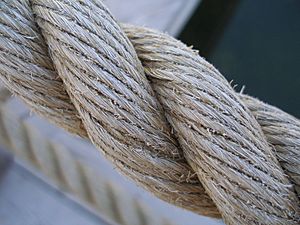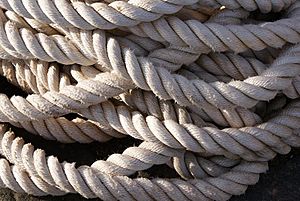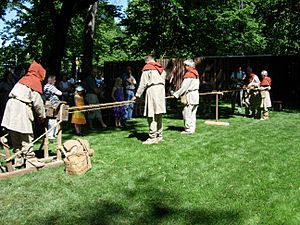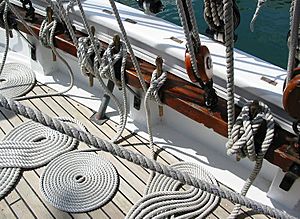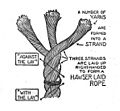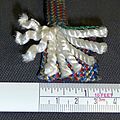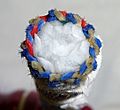Rope facts for kids
A rope is a strong, long piece of material. It is made from many fibers twisted or braided together. This makes the rope very strong for pulling things or connecting them. Ropes are great for pulling, but they are too flexible to push anything. Ropes are usually thicker and stronger than similar items like cords, lines, strings, or twine.
Contents
How Ropes Are Made: Materials and Construction
Ropes can be made from many different materials. Some ropes use natural fibers. These include materials like manila hemp, hemp, linen, cotton, coir (from coconuts), jute, and sisal.
Today, many ropes are made from synthetic fibers. These are man-made materials. Common synthetic fibers for ropes include polypropylene, nylon, and different types of polyester. Other strong synthetic fibers are polyethylene (like Spectra) and aramids (like Kevlar). Sometimes, ropes are made from a mix of different fibers. Ropes can even be made from metal. In the past, people also made ropes from silk, wool, or hair.
Using Ropes: From Ancient Times to Today
Ropes are super important in many areas of life. They are used in construction, for seafaring (on ships), in exploration, and for many sports. Ropes have been essential since ancient times.
To fasten a rope, people use many different knots. Each knot has a special purpose. Pulleys are tools that help change the direction of a pulling force. They can also make it easier to lift heavy things. This is called creating a mechanical advantage. Winches and capstans are machines that help pull ropes.
Rope Through History: An Ancient Invention
People have used ropes for a very long time. They used them for hunting, pulling, tying things, carrying, lifting, and climbing. Ropes have always been key to human progress. The first "ropes" were probably natural plant vines. Soon after, people learned to twist and braid these plants together. This created the first real ropes. Scientists found pieces of rope in a cave called Lascaux. These pieces are about 17,000 years old!
The ancient Egyptians were likely the first to create special tools for making rope. Egyptian ropes date back to 4000 to 3500 B.C. They often used water reed fibers. Other ancient ropes were made from date palm fibers, flax, grass, papyrus, leather, or animal hair. These strong ropes helped the Egyptians move the huge stones needed to build their monuments. Around 2800 B.C., ropes made of hemp fibers were used in China. The skill of rope making then spread across Asia, India, and Europe.
In the Middle Ages (from the 1200s to the 1700s), ropes were made in special rope walks. These were very long buildings. Workers would spread out the rope strands along the entire length of the building. Then, they would twist them together to form the rope. This allowed them to make very long ropes, sometimes over 300 yards long. Long ropes were very important for tall ships. They needed ropes that were long, strong, and had a consistent thickness.
Leonardo da Vinci drew ideas for a rope-making machine. But like many of his inventions, it was never built during his lifetime. Even without modern machines, amazing things were done. In 1586, a man named Domenico Fontana moved a huge 327-ton stone pillar. He did this in Rome's Saint Peter's Square. It took 900 men, 75 horses, and many pulleys and ropes to do it! By the late 1700s, several working rope-making machines were invented.
Today, some ropes are still made from natural fibers like coir and sisal. However, synthetic fibers like nylon and polypropylene have become very popular since the 1950s.
Taking Care of Ropes
Ropes made from hemp, cotton, or nylon should be kept in a cool, dry place. To keep them from getting tangled, ropes are usually coiled up. To stop the ends of a rope from fraying, they are often tied with twine or tape. The ends of plastic fiber ropes can also be melted to seal them.
If a rope that holds weight gets a sudden jolt, or if it looks damaged, it should be replaced right away. You should not use it for anything important again. Most ropes last about five years. After that, they need to be checked very carefully.
When getting ready for climbing, it's good to lay the rope out. Check it for any weak spots. Try to avoid stepping on ropes. Small pieces of rock can get pushed into the rope's outer layer. Over time, this can damage the inside of the rope.
What is a Line?
Sometimes, a piece of rope that has a special job is called a "line." This is especially true in sailing. For example, you might hear about a clothesline, a chalk line, an anchor line, or a fishing line.
Images for kids
-
Bollard and mooring line
-
A piece of preserved rope found on board the 16th century carrack Mary Rose
-
A ropewalk in Karlskrona, Sweden
See also
 In Spanish: Cuerda para niños
In Spanish: Cuerda para niños



